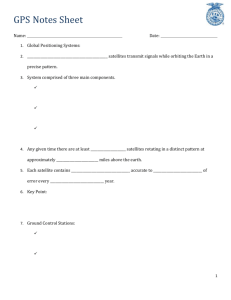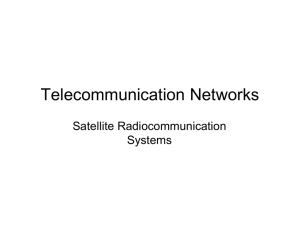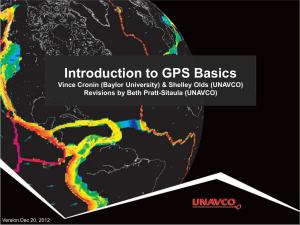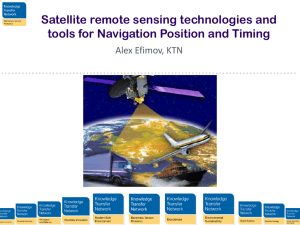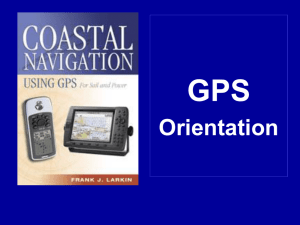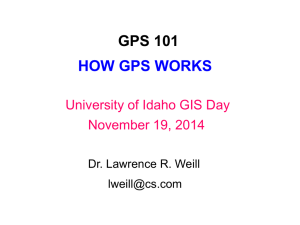Chapter 16 GPS Satnav
advertisement
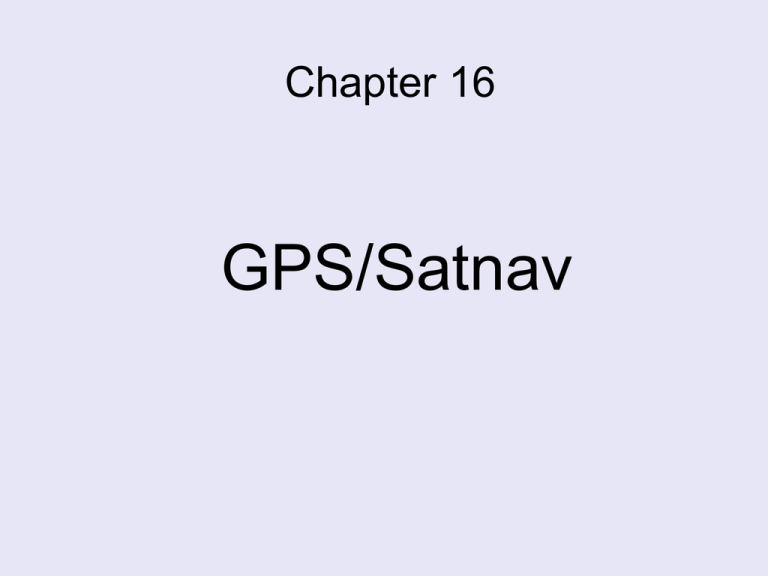
Chapter 16 GPS/Satnav GPS Global Positioning System Will eventually replace the older, radio/radar based systems of VOR, ILS and NDB. The US system is GPS, Europe’s system is Galileo. Global Navigation Satellite System GLONASS Global'naya Navigatsionnaya Sputnikovaya Sistema GPS Constellation There are 24 satellites in orbit: 21 active plus 3 spares. They are 11,000 miles above the earth. They have 6 orbital planes which take 12 hours to complete one orbit. At least 5 or more satellites are available for navigational use at one time. A B C D E F 4 5 5 (6) 5 6 5 Number of satellites 30 http://www.navcen.uscg.gov/. Schriever Air Force Base 3 GPS Segments There are 3 major components of the GPS System. The Space Segment consists of satellites (SV’s for Satellite Vehicles). Page 114 The Control Segment is a station located in Colorado Springs that connects to 5 or more ground stations around the world. Orbit information and clock corrections are uplinked to the satellite several times a day. The User Segment consists of airplanes, ships, other vehicles and portable GPS. Satellite Signal Frames The signal is broadcast in “frames” of information. Page 113 Signal Transmission The signal from the satellite is transmitted as a pulse code, each satellite sends a unique code. The receiver in the airplane already knows the code patterns sent by every satellite. It searches until it finds a satellite signal that matches a stored pattern. By comparing this time with the time or arrival at the receiver, a time difference is calculated. This is multiplied by the speed of light (the speed of signal transmission) and the answer is distance. On A Off On Off B On Off On Off On Off A+B A B GPS Frequencies Page 110 L1 was shared between civil and military use. L2 was exclusively military and used in conjunction with L1. The advantage of using 2 frequencies is the ability of the receiver to measure and correct propagation error. L1 = 1575.42 MHz L5 = 1176.45 MHz L5 L1 L5 L1 WAAS Wide Area Augmentation System page 115 WAAS is a form of differential GPS designed to bring the accuracy up to Category I approach standards. The 25 ground stations are spaced several hundred miles apart all over the US. These stations are precisely surveyed so their exact position is known. The ground stations pick up the signal and determine the error. LAAS Local Area Augmentation System Receiver Autonomous Integrity Monitoring (RAIM). When GPS equipment is not using integrity information from WAAS or LAAS, the GPS navigation receiver using RAIM provides GPS signal integrity monitoring. RAIM needs a minimum of 5 satellites in view, or 4 satellites and a barometric altimeter (baro−aiding) to detect an integrity anomaly. For receivers capable of doing so, RAIM needs 6 satellites in view (or 5 satellites with baro−aiding) to isolate the corrupt satellite signal AC Advisory Circulars AC 20−138, Airworthiness Approval of Global Positioning System (GPS) Navigation Equipment for Use as a VFR and IFR Supplemental Navigation AC 20−130A, Airworthiness Approval of Navigation or Flight Management Systems Integrating Multiple Navigation Sensors, or equivalent. Equipment approved in Introduction to EFIS Electronic Flight Instrument System Electronic Flight Instrument System EFIS Textbook page 124 Review Q&A Chapter 16 GPS/Satnav 16.1 How many satellites are there in a GPS constellation? Answer: 24. 16.2 How many GPS satellites are active? How many are spares? Answer: 21, 3 16.3 What is the European equivalent of GPS? Answer: Galileo 16.4 Why don’t GPS receivers in airplanes require expensive atomic clocks (like those in satellites) to measure time with high accuracy? Answer: The receiver gets the clock time from the satellite and corrects for error. 16.5 How does a GPS receiver identify a satellite? Answer: By it’s unique pulse code. 16.6 What is the term for a satellite's identity? Answer: PRN Code, or pseudorandom code. 16.7 How does a GPS receiver measure the time for the signal to travel from satellite to receiver? Answer: By comparing the transmit time with the time the signal was received. 16.8 How is distance determined between the GPS receiver and the satellite? Answer: By taking the time it takes for the signal to travel and multiplying by the speed of light. 16.9 GPS frequencies, or channels, are designated by the letter ____. Answer: L. 16.10 How many satellites are required for a three-dimensional fix (latitude, longitude and altitude)? Answer: 4 16.11 How many satellite frequencies are required to perform propagation corrections? Answer: 2 16.12 What part of the satellite signal carries the satellite’s precise position in orbit? Answer: The Ephemeris 16.13 Name the three segments of the GPS system. Answer: Space, User and Command 16.14 The Wide Area Augmentation System (WAAS) uses ground stations and satellites to ____. Answer: Bring GPS up to Category I standards 16.15 What is the advantage of LAAS (Local Area Augmentation System) over WAAS? Answer: More precise for that airport. 16.16 What is the purpose of RAIM (Receiver Autonomous Integrity Monitoring)? Answer: To insure that GPS is functioning up to precision approach standards.

